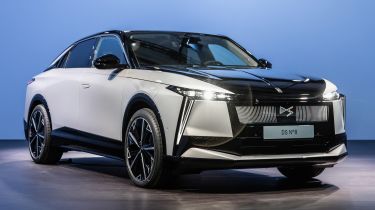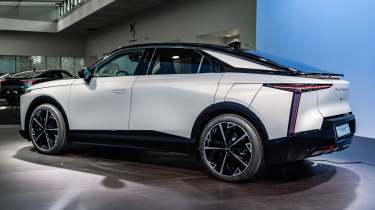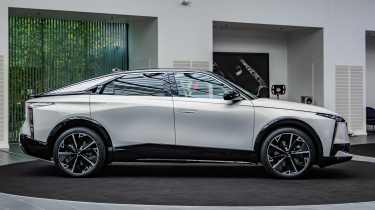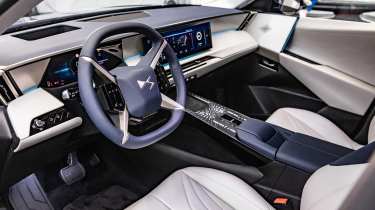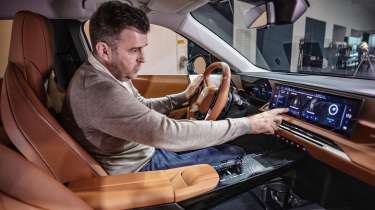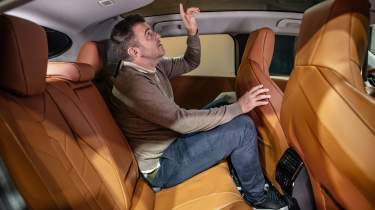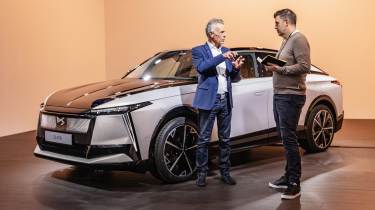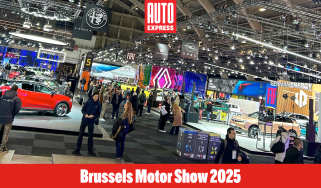DS No8 2025 preview: walkaround, specs, prices and on-sale date
A new dawn for DS, the No8 promises ‘character’ and ‘serenity’ to buyers in the premium car market, but is it good enough to convince?
DS isn’t giving up. The Parisian premium brand from the Stellantis Group has been banging its head against a brick wall trying to compete with German rivals in the European car market since it separated from Citroen in 2014, without making much of a dent. Now we have the DS No8, a new car with a new design direction that ushers in a new naming strategy. It’s conceived to woo buyers who would otherwise give their cash to the likes of BMW, Audi and Mercedes, or maybe even Tesla and Polestar.
The DS No8 will go on sale in mid-2025, with estimated prices in Europe likely to be between £45,000 and £72,000. It’s a spacious mid-size coupé-SUV with an electric powertrain, but it symbolises a bit more than that. This is DS refining its pitch to consumers, separating itself from the morass of apparently overlapping brands that constitute the Stellantis stable by doubling down on luxury, comfort and what it refers to as ‘serene’ qualities. In the DS world, serenity means an easy, hiccup-free ownership experience – think practicality, autonomy, efficiency, fast charging and a long range.
On paper, the No8 looks pretty good on all counts. The largest battery on offer is a prodigious 97.2kWh unit that can carry the model to a headline-grabbing official WLTP range of 466 miles. That’s class-leading, eclipsing the cars that DS has identified as core rivals for the No8, the Polestar 4, Tesla Model Y, BMW i4 and Audi Q6 e-tron. The boot is a vast 620 litres, even under that dramatically angled fastback rear end, and the DS No8 will even tow up to 1,600kg, which is highly respectable for an electric car.
The DS No8 also launches a subtly different naming strategy for the brand. No more DS 7, DS 3 and DS 4, the next generation of DS cars will be known as the DS No7, DS No3, etc. The brand’s very first concept car, back in 2012 when DS was a Citroen sub-brand, was called the DS Numero 9, so the new names aren’t entirely unprecedented. Issues may arise with any future DS No5, however, as negotiations with Chanel could prove tricky…
The link created by the new names to the top echelon of French fashion is entirely deliberate. So is the emphasis on global fashion capital, Paris, as the spiritual (and actual) home of DS – the place where the original Citroen DS was designed and built. DS wants to sell itself as Parisian more than merely French, referencing its roots and playing up to the haute couture connotations are part of that process.
“It all happened in Paris,” explained Thierry Métroz, Senior Vice President of DS Design. “It all happened in the 15th District of Paris and we are a Parisian brand. It's a very strong advantage, the link with Paris and its other luxury brands. Our ambition for DS is to be the Louis Vuitton of the automotive industry.”
| Key specs | |
| Fuel type | electric |
| Body style | 5-door coupe SUV |
| Powertrain | Single e-motor (FWD) or dual e-motor (AWD) |
| Price | £45,000 to £72,000 |
What powertrain options and performance can we expect?
There are three powertrain options with the DS No8. The base front-wheel-drive model gets a 74kWh battery and 227bhp, but there is an overboost-like extra power function that can deliver an additional 30bhp in short bursts taking the total to 257bhp. Torque is rated at 345Nm, and that’s enough for a 0-62mph time of 7.7 seconds. All DS No8 models have the same top speed of 118mph.
The other cars both get the larger 97.2kWh battery. The FWD High Range has more power at 242bhp, or 276bhp with the extra power function, but the same 345Nm of torque. The additional weight of the bigger battery blunts 0-62mph performance to 7.8 seconds.
The flagship model is the only 4x4 option, with a dual motor configuration making all-wheel-drive possible. The intelligent 4x4 system runs mainly in front-wheel drive when Eco and Normal drive modes are selected, engaging the rear wheels when slip is detected, but Sport and AWD modes are permanent all-wheel drive. With 345bhp (370bhp in extra power mode) and 511Nm of torque, it’s markedly faster than the others, returning a 5.4-second 0-62mph time.
The DS No8 has three brake energy regeneration modes governed by paddles behind the steering wheel. Plus there’s a ‘one pedal mode’ that can bring the car to a complete stop. The DS Active Scan Suspension tech also features, using cameras to monitor the road surface ahead and prime the suspension accordingly to help absorb bumps.
| Model | Power | 0-62mph | Top speed |
| DS No8 FWD | 227bhp | 7.7 seconds | 118mph |
| DS No8 FWD High Range | 242bhp | 7.8 seconds | 118mph |
| DS No8 AWD Long Range | 345bhp | 5.4 seconds | 118mph |
What do we know about the range, charging and running costs?
We know that the DS No8 sets new standards for electric driving range in the mid-size premium class. Few cars of any kind can beat the 466 miles that the FWD High Range model promises to achieve on the official WLTP tests, where it records efficiency of over 4.8mi/kWh. Engineers also claim the car can deliver a 500km (310-mile) range at a constant speed of 75mph, suggesting strong performance on the long, high-speed motorway journeys where EV efficiency can sometimes falter.
A big reason for the DS No8’s strong efficiency is the focus that the brand has put on aerodynamics. DS is claiming another ‘best in class’ accolade in this area, with a drag coefficient of 0,24 Cd and a CdA rating of 0,63. Contributing to this are features such as the active air intakes in the front bumper, the flat underbody and the sleek fastback roofline.
With the base model capable of 355 miles on a full charge and the larger battery variants both sailing far past the 400-mile mark, DS sees the No8, and its longest-range rivals, as being at a point that can consign EV range anxiety to history. “500 kilometres; even if you are able to do it with your fuel car, you don’t do it, you need to stop,” said DS Head of Interior Design Thomas Bouveret. Then when you do make a stop, the charging performance is there to ensure it doesn’t need to be a long one.
Indeed, DS claims to have class-leading charging capabilities to go with its class-leading range. The FWD High Range model can charge from 20 per cent to 80 per cent in 27 minutes on a 200kW charger, but the real advantage it brings is the ability to draw close to 160kW consistently all the way from 20 per cent to 55 per cent.
Some rivals can charge faster in short peaks, but the DS No8 charging curve is much flatter for longer, enabling it to recover 200km (124 miles) of range every 10 minutes up to 55 per cent. It should be ideal for a quick get-you-home top up. On a standard 7.4kW home wallbox, a 20 to 80 per cent charge in that larger battery car should take around eight hours and 50 minutes.
| Model | Battery size | Range | Efficiency |
| DS No8 FWD | 74kWh | 355 miles | 4.8m/kWh |
| DS No8 FWD High Range | 97.2kWh | 466 miles | 4.8m/kWh |
| DS No8 AWD Long Range | 97.2kWh | 426 miles (est) | 4.3m/kWh |
What is the exterior and interior design like?
DS wants the design of the No8 to set the framework for how its new generation of cars will look. The current DS range can seem a little chintzy and over-designed with a lot going on, both inside and out. The No8, in contrast, pushes things in a more pared back, elegant direction, taking its cue from the DS Aero Sport Lounge concept revealed in 2020.
The latest incarnation of DS’s blade daytime running lights are perhaps the standout exterior features, jutting down from the main light clusters at each corner of the car. They also serve to form a sharp edge at the No8’s extremities, which further helps the aerodynamics. All bar the entry-level cars also get the Luminascreen grille with its light bars and illuminated DS badge, while higher spec models can be had with what the brand says is the only two-tone bonnet in mass production.
Inside, is where the No8 really looks to press home its advantage over rivals. The car has a cabin environment that feels quite different from those of other models in the premium SUV class, and from anything else currently offered by the Stellantis Group. There are two trim levels, Etoile and Pallas, plus a range of five different cabin material packages. All of these provide a range of classy finishes with aluminium, leather or Alcantara covering most of the surfaces inside, highlighted by an eight-colour ambient lighting system.
The blade light bars from the outside are mirrored inside the doors by lights that run down the edge of the speaker covers. These also form the only easy place to grab and pull the door closed, but don’t quite feel robust enough for that job when you give them a firm tug.
The steering wheel is a highly unusual ‘X’ design with four spokes that jut off to the rim from each corner of the central hub. DS says it gives drivers more options to hold the wheel comfortably than the classic ‘quarter past nine’ hand position, but we’ll reserve judgement until we drive the car. What we can say is that the wheel is small and feels good in the hand, even if the touch-sensitive panels for the wheel-mounted controls seemed a little wobbly on the pre-production model we saw.
The centre console has a two-tier design with a narrower floating top section, including drive mode controls and a wireless charging pad. A wider tier below has storage and charging ports. This aids driver kneeroom, because your lower leg can rest on the padded surface of the wider lower tier, stopping your knee coming into contact with the top tier. The design seems logical and keeps cables out of view, but the lid of the under armrest storage area closes with a cheap-sounding plastic click.
There’s no doubt that the DS No8 cabin looks and feels upmarket and what’s especially notable is that this is true of the entry-level car. There’s no impression that you’re missing out on the good stuff in the base model, which still features abundant leather trim and aluminium detailing of the kind few rivals offer these days.
What do we know about the infotainment system?
The DS No8 has a new infotainment system based around a wide screen that stretches for 16 inches across the dash. The screen is sharp, and the software interface has a classy look that blends seamlessly with the car’s interior, taking on the selected ambient lighting colours.
It’s suitably stylish and seemed fast enough to respond, but the software in the static demonstration car we viewed in the DS Paris design studio was still some way behind what customers will ultimately receive in their production models. There are no configurable shortcut buttons, but drivers can configure the layout of the menu screens and the No8 does have a panel of fixed buttons below the screen for the key controls.
How practical is the DS No8 and how big is the boot space?
The DS No8 uses the Stellantis STLA Medium platform that also underpins the Peugeot 3008 and the Vauxhall Grandland. It’s longer and lower than these traditionally proportioned mid-size SUVs, however, which has allowed DS to stretch the passenger compartment to improve the amount of space.
Starting in the front, the driving position has a good range of adjustment, particularly for seat height. The No8 might be lower than most SUVs, but you can select a higher driving position if you prefer. Headroom up front is good enough to allow this, even for drivers over six feet tall.
The seats themselves incorporate a couple of interesting innovations. They look slightly unusual at first glance, because DS has slimmed down the shoulder sections substantially in a bid to provide a clear forward field of vision for those in the rear. Sitting in the seats, they feel comfortable and you certainly don’t notice any lack of support in the shoulder area. In the back, there’s a pleasantly open feel because you can see more through the windscreen.
In the centre of the front seats is an aluminium hole from which the DS No8 can deploy its ‘neck scarf’. It’s essentially an extra air vent for the heating and ventilation system that allows the driver to cut energy use by blowing hot air down the back of their neck. Because the neck scarf can work independently of the other vents, it’s a way of directly warming occupants, rather than inefficiently heating all the air in a cabin that might only contain one person. The front seats in the car we saw were heated and ventilated (with a massaging function) to further reduce the need for whole-cabin climate control and, unusually, DS also offers heated and ventilated rear seats in the No8.
In the back, the clear forward view and the standard full-length glass roof provide a very airy environment. Passenger space is adequate rather than ample, but you have to remind yourself that this is a mid-size SUV, not a luxury saloon. A six-foot rear passenger can sit behind a similarly sized driver, but their knees will be close to the seat back, and although there is some room to put your feet under the front seat, it’s quite tight. Getting a third adult in the middle seat on the rear bench would be a challenge.
The boot of the DS No8 is a whopper. The capacity is 620 litres, and the floor area is particularly impressive at 1,165mm from the loading lip to the seat backs. There are netted pockets at each side for smaller items and a good-size compartment under the floor as well, which is ideal for your charging cables but also provides room for other stuff. If all that’s not enough, the DS No8 can tow a braked trailer of up to 1,600kg – a significant amount for an EV.
| Dimensions | |
| Length | 4,820mm |
| Width | 1,900mm |
| Height | 1,580mm |
| Number of seats | 5 |
| Boot space | 620 litres |
What safety tech does the DS No8 have?
Safety provision on the DS No8 is built around the brand’s DS Drive Assist 2.0 suite of active driver aids. Lane Positioning Assist (LPA), Active Lane Change Assist (A-LCA) and One-Touch Semi-Automatic Lane Change (SALC) all feature, along with the adaptive cruise control that can bring the car to a stop in traffic, then drive it away again. What’s new is the Anticipated Speed Adaptation (A-ISA) system, an extension of the adaptive cruise control which uses mapping information and sensors in the car to adjust the car’s speed for corners, roundabouts and speed limit zones. It’s designed to make cruise control more useful on A- and B-roads.
In the infotainment system, DS has provided a shortcut button to the driver assist menu. Pressing it once can enable or disable features like the speed limit warning and the lane-departure warning individually, while holding the button down turns everything off.
What will the DS No8 price be?
We’ve been given a good steer on European pricing for the DS No8, with the range expected to sell for the euro equivalent of between £45,000 and £72,000 – although prices are likely to be a shade higher in the UK. This is a similar ballpark to the rivals that DS has identified, such as the BMW i4, Tesla Model Y and Polestar 4. However, the elephant in the room for DS has long been its brand equity in the eyes of consumers.
The challenge for DS is to convince the market that it’s worthy of consideration alongside the established premium players. The No8 looks like a step in the right direction, but as DS has found up to now, the road to customer acceptance for a premium brand is very hard to negotiate.
Click here for our list of the best electric SUVs...

